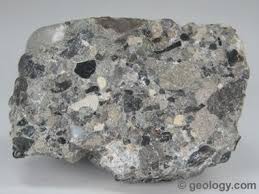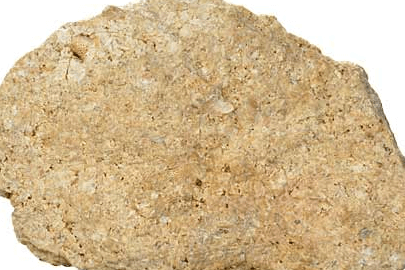Rocks that have been formed from other rocks, sedimentary and igneous, by internal changes caused by pressure, heat, and the chemical action of the solutions and hot gases, are called metamorphic rocks and here is a list:
Crystalline Limestone
Crystalline Limestone is a rock that results from the crystallization of the calcite in sedimentary limestone. More or less of the calcite may have been replaced by carbonate of magnesia, forming dolomitic limestone; or, when the replacement has gone far enough, the rock becomes dolomite.
The impurities in the limestone and other materials brought from without, appear in the crystalline limestone as crystals of mica, tremolite, garnet, titanite, magnetite, graphite, etc. Banding or schist-structure is sometimes present, and crystalline limestone sometimes shades into calc- schist.
Slate
True slates have been formed by the change of shale, mud, or clay, by pressure and heat, into a compact fine-grained rock, which can be split into smooth sheets or thin slabs. The direction of cleavage is not usually that of the original strata, but may cross it at any angle. The stratification has more or less completely disappeared, and the slaty cleavage has been developed by pressure. Heat or pressure has destroyed the clayey property of the shale, etc., and the microscope shows the growth of small crystals of quartz, mica, and other minerals.
Slate is fairly soft, and it can be cut and punched; its value depends on this, and on its clean, easy splitting. The original stratification, or bedding, sometimes shows as lines, called “ribbons,” which may spoil the slate. The slaty structure is sometimes found in rocks not originally of a clayey nature; for example, volcanic ash rocks. These slates are not so likely to be merchantable.
Phyllite
Phyllite is a slaty rock in which crystallization is farther advanced than in true slate. It is distinctly micaceous, and is intermedíate between slate and mica schist.
Graywacke
Graywacke is a metamorphosed shaly sand-stone or similar fine-grained rock of mixed composition. It is mostly intermediate between slate and quartzite, and can sometimes be seen shading into one or the other of these. It gets its name from the usual gray color.
Quartzite
Quartzite rock is formed from sand-stone by the complete filling of the spaces between the grains with secondary quartz, that is, silica, crystallized upon the grains of quartz or around the grains of other minerals. It is a hard compact rock, which breaks with a conchoidal (shell-like) or splintery fracture, unlike the rough-grained break of sandstone. In quartzite, the break passes through the grains of quartz; in sandstone it passes between them. The grains are sometimes visible in quartzite, although not so distinct as in sandstone. Crystals of mica, feldspar, epidote, magnetite, etc., may be scattered through the rock; but sometimes quartzite is a very clean, white rock, almost pure silica. The color is sometimes gray, yellowish, greenish, or reddish. The hardness is that of quartz, H = 7; and the specific gravity is also near that of quartz, G = 2.6.
The great hardness of quartzite makes it difficult to drill and dress; but, on account of its durability, it is sometimes used as a building stone. The crushed rock makes good railroad ballast and concrete. Pure white quartzite is ground and used in making glass. It is also used in the manufacture of ferro-silicon, and silica brick.
Gneiss
Gneiss is a banded rock, composed of the same minerals as granite, syenite, diorite, gabbro, etc., the crystals of which are mostly large enough to be seen. Thus there are varieties called granite-gneiss, diorite-gneiss, gabbro-gneiss, etc., Gneiss made by metamorphosis of a sedimentary rock is called para-gneiss. Gneiss is sometimes changed sedimentary rock, and sometimes it has been formed from an igneous rock; in both cases the banding has been developed by pressure. The banded structure may also have been caused by the flowing and drawing out of the stiffening magma. When of sedimentary origin, the materials of the original sedimentary rocks have been chemically changed and crystallized.
In some places, gneiss can be seen grading into conglomerate, clayey sandstone, or granite, etc. The commonest gneiss is that which has the composition of granite. The banding may be very distinct or it may be quite irregular. Gneiss sometimes splits readily, and is then easily worked into blocks for foundations, etc.
Schists
Schists are rocks in which the changes caused by pressure have gone farther than in slate, quartzite, and gneiss, so that a structure of thin layers or sheets has been developed — the schistose, or foliated, structure. Schists are distinctly crystalline. In composition there are many varieties, named after some conspicuous mineral; as, mica schist, chlorite schist, talc schist, hornblende schist, quartz schist, etc. Calcareous schist or calc- schist, has been formed by the metamorphism of impure limestone. Any rock may be changed to a schist. The first stages of such a change in conglomerate can be seen in the lengthening of the pebbles as in figure 124.
Serpentine
Serpentine rock is composed largely or altogether of the mineral serpentine, a hydrated silicate of magnesia. It has been formed by the change of basic rocks composed mostly of olivine, hornblende, pyroxene, etc., for example, peridotite, hornblende schist, and pyroxenite. Water has taken part in the change, and the resulting principal mineral is hydrated. The origin of the serpentine rock can sometimes be seen in a little olivine, pyroxene, or hornblende, which remains unchanged.
Soapstone or Stealite
Soapstone or Stealite rocks are composed mostly of the mineral talc with mica, chlorite, tremolite, pyroxene, etc. Color, bluish or greenish gray, sometimes dark gray. May be considerably harder than pure talc, but is soft enough to be easily quarried and cut. It is used mostly in the manufacture of table tops, sinks, and gutters in chemical laboratories, laundry tubs, switch boards, etc. The harder varieties are used for stair treads. Soapstone free from the harder minerals is ground and used as a lubricant.
The following list gives the names of some well- known sedimentary and igneous rocks, on the left- hand side, and opposite each the metamorphic rock into which it is changed by the processes described above:
Sedimentary Rocks changed to Metamorphic Rocks
- Conglomerate to Gneiss and schist
- Sandstone to Quartzite and gneiss
- Shale to Slate and schist
- Limestone to Crystalline limestone and schist
Igneous Rocks changed to Metamorphic Rocks
- Granite to Gneiss
- Syenite to Gneiss
- Diorite, etc. to Gneiss
- Rhyolite, porphyry, etc. to Schist
- Gabbro, basalt, etc. to Schist
- Peridotite, etc. to Serpentine
- Pyroxenite, etc. to Serpentine
What is Metamorphism
Definition of Metamorphism:
After consolidation, some sedimentary and igneous rocks have undergone more or less change because of heat, pressure, and the chemical action of hot solutions and gases from igneous rocks. In this way, the structure of the rocks has sometimes been altered very much. For example:
- (a) by growth of crystals in limestone;
- (b) a laminated structure developed that was different from the original stratification, as when shale is changed into slate;
- (c) new mineral combinations were formed, as when olivine is changed into serpentine. This process is called metamorphism, and the resulting rocks are called metamorphic rocks, which means changed or altered rocks.
By metamorphism, granite has often been changed to gneiss, the pressure having caused the granite to squeeze out or flow, so as to develop a somewhat stratified appearance, conspicuous minerals like black mica having been pressed out and gathered into layers of concentration. This process carried further produced schists, rocks with a sheeted or laminated structure. Gneiss and schists have also been formed by metamorphosis of sedimentary rocks, where these have contained the materials for the formation of the characteristic minerals, feldspar, mica, quartz, etc. In some places the metamorphic rock, say gneiss, can be seen shading into the corresponding sedimentary rock, (a conglomerate or an impure sandstone) or into the corresponding igneous rock (granite, syenite, etc.)
The heat, which is one cause of metamorphism, has come partly from the hot interior and partly from the pressure and internal movement which accompany folding. Fossils have been almost completely destroyed in sedimentary rocks that have been metamorphosed.
In their crystalline structure, most metamorphic rocks resemble igneous rocks. In an appearance like stratification, they resemble sedimentary rocks.
The changes here mentioned may have taken place throughout large extents of rock by the action of heat, pressure, or hot solutions or gases, working on a large scale (regional metamorphism), or they may have been confined to the local influence of hot masses such as those that formed dikes, etc. (local or contact metamorphism). The rocks at these contacts have become crystallized; and the change sometimes extends for a considerable distance from the contact, occasionally a mile or more where the igneous intrusions are large.

